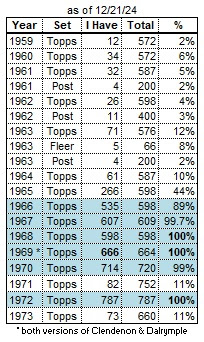Here's relief pitcher Darold Knowles, sporting the windbreaker UNDER uniform look. Knowles was the ace of the Phillies' bullpen as a rookie in 1966.
Darold was signed by the Orioles in 1961, and pitched 5 seasons in their minor-league system. Early on, he was primarily a starting pitcher, but in '64 and '65, about half his appearances were out of the bullpen.
He made his major-league debut in April 1965, but only pitched 5 games for the O's that year.
After the season, he was traded to the Phillies (along with veteran
outfielder Jackie Brandt) for Jack Baldschun, who had been the
Phillies' closer from 1962-65. Knowles soon worked his way up to the top of the Phillies' bullpen, appearing in 69 games (the most of any Phils pitcher, and 33 more than any other reliever) and collecting 13 saves (9 more than the next guy). Darold came along at the right time, since the heir-apparent to Baldschun's fireman role (Gary Wagner) had a disastrous 1966 season.
He was one-and-done in Philly, getting shipped off to the Senators for center fielder Don Lock. Knowles spent 4-plus seasons in Washington's bullpen before a May 1971 trade hooked him up with the contending Oakland Athletics.
Although generally the team's top reliever during his stay in DC, with Oakland Knowles pitched in the shadow of Rollie Fingers. Darold pitched in the 1971 ALCS vs. Baltimore, and the 1973 World Series vs. the Mets.
Knowles was traded again after the 1974 season, and pitched 5 more full seasons for the Cubs, Rangers, Expos, and Cardinals. His last game was on April 18, 1980 - fifteen years to the day after his major-league debut.
Subscribe to:
Post Comments (Atom)




.jpg)

.jpg)




















2 comments:
That 'windbreaker under the jersey' look was pretty common back then. I wonder if it had to do with the greater need to 'get in shape' players felt. Nowadays conditioning is a year round activity. Back then a lot of guys had off-season jobs and really relied on spring training to 'sweat it off'. Just a wild theory on my part.
The text on the back of the card makes a reference to Ron Kline, without mentioning his name.
Post a Comment